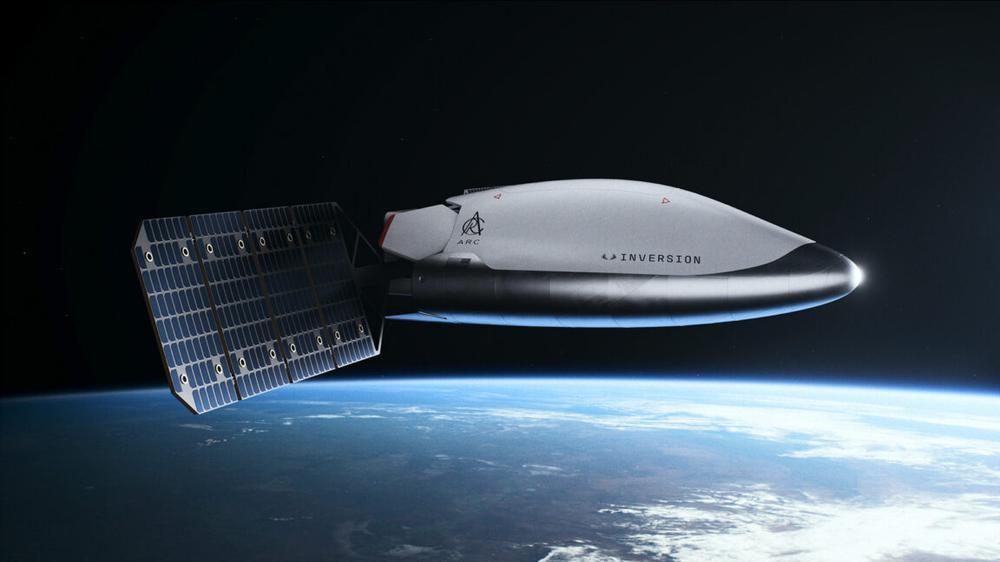A relatively new spacecraft company, Inversion, revealed its new "on demand" delivery vehicle Wednesday evening during a splashy ceremony at its factory in Los Angeles.
The company said it is building the Arc spacecraft to provide a capability to the US military to deliver as much as 500 pounds (225 kg) of supplies almost anywhere in the world, almost instantaneously.
"The nominal mission for us is pre-positioning Arcs on orbit, and having them stay up there for up to five years, able to be called upon and then autonomously go and land wherever and whenever they're needed, being able to bring their cargo or effects to the desired location in under an hour," said Justin Fiaschetti, co-founder and chief executive of Inversion, in an interview with Ars before the event.
Inversion was founded in early 2021 by Fiaschetti and Austin Briggs. Both were students at Boston University. Fiaschetti had internships at SpaceX and Relativity Space, where he worked on propulsion. He dropped out of Boston University to co-found Inversion because of a simple idea.
Space is a highway
"Space is fun to talk about as a destination, and people really were talking about it that way then," Fiaschetti said. "But the true economic value of space is accessing the globe, and we realized we could do that with physical cargo, rather than with just data. And so we founded Inversion to go and build reentry vehicles to go do that."
Three years later the company, with just 25 employees, cobbled together a small spacecraft named "Ray" as a demonstration of its technology. It launched as part of SpaceX's Transporter-12 mission in January of this year. Ray was intended to fly in space using Inversion's in-house subsystems before firing its bipropellant rocket engine to perform a deorbit burn and land off the coast of California.
The test spacecraft, with a mass of about 200 pounds (90 kg) performed well, Fiaschetti said. It demonstrated the capability to raise and lower its orbit, and remains power positive to date, periodically checking in with Inversion flight controllers. However, the spacecraft will not make a controlled landing.
"Ray won't be coming back," Fiaschetti said. "We're doing long-term testing of software on orbit."
Although Ray did not land, Inversion now feels confident enough in its technology to move into the production of the larger Arc vehicle, which was unveiled on Wednesday evening. About the size of a large table top—Arc is four feet wide and eight feet tall—the company is aiming to launch the first Arc vehicle by the end of 2026. Fiaschetti said Inversion is "on a really good path" to make that timeline.
So what does the military want to ship?
Arc is a lifting body spacecraft, and it will do the majority of its maneuvering in the atmosphere, where it has 1,000 km of cross-range capability during reentry. It will land under parachutes and therefore not require a runway. Because the vehicle's propulsion system uses non-toxic materials, a soldier can approach it immediately after landing without any protective gear.
So what would the US military want to pre-position in space for delivery at a moment's notice to any location around the world?
"We like to describe this as mission-enabling cargo or effects," Fiaschetti said. "This could be a wide variety of specific payloads, anything from medical supplies to drones to what have you. But the key discriminator is, does this make a difference in the moment it's needed when it gets back down to the ground? You know, for the military and national security, if they need their cargo before the fight is over."
The company says it has already built a "full-scale manufacturing development unit of the primary structure" for the first Arc vehicle. It would be an impressive capability if the small team at Inversion—now 60 people strong, and growing—can bring the Arc spacecraft to market. If, of course, is the operative word. "Space is hard" may be a cliché, but it also happens to be true.

 AU Deals: Extra Early Gaming Gems From the Amazon Prime Big Deal Days Sale
AU Deals: Extra Early Gaming Gems From the Amazon Prime Big Deal Days Sale